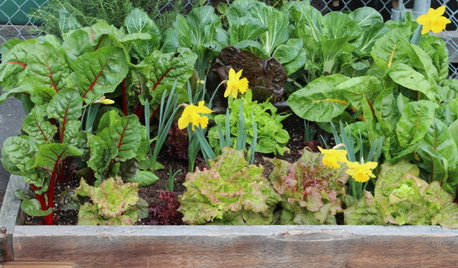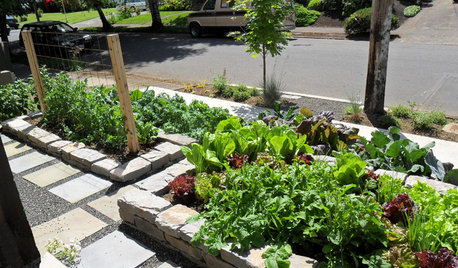Chard question
sage721
13 years ago
Related Stories

GARDENING GUIDESEssential Watering Tips for Your Edible Garden
To give your edible plants just what they need, check out these guidelines for how, when and how much to water
Full Story
FARM YOUR YARDHouzz Call: Home Farmers, Show Us Your Edible Gardens
We want to see where your tomatoes, summer squashes and beautiful berries are growing this summer
Full Story
GARDENING GUIDES10 Easy Edibles for First-Time Gardeners
Focus on these beginner-friendly vegetables, herbs, beans and salad greens to start a home farm with little fuss
Full Story
EVENTSOn Show: Weird, Wondrous Science Meets Design
Houses grown, not built. Power-generating soil. And snail poop that ... well, see for yourself in our coverage of a new Rotterdam exhibit
Full Story
EDIBLE GARDENSGarden BFFs? Why Your Vegetables Are Begging for Companion Plants
Foster friendships among plants for protection from pests, pollination support and color camaraderie
Full Story
FARM YOUR YARDIf You Have Room for Only One Summer Crop ...
Get an edible that’s long on flavor even if you’re short on space, with a long-time gardener’s favorite picks
Full Story
FARM YOUR YARDGrow a Kitchen Garden in 16 Square Feet
Got a sunny 4-by-4 space? You can make meals more interesting with your own vegetables and herbs
Full Story
FARM YOUR YARDHow to Grow Vegetables in Containers
Get glorious vegetables and fruits on your patio with a pro’s guidance — including his personal recipe for potting mix
Full Story
FRONT YARD IDEASWelcome Edibles Into the Front Yard for Fresh Food and More
Give your front yard design a boost and maybe even make new friends by growing fruits and vegetables
Full Story
FARM YOUR YARD10 Easy Edibles to Grow in Containers
These herbs, vegetables and fruits are just as happy in a pot as they are in the ground
Full StoryMore Discussions






pippimac
denninmi
Related Professionals
Holly Springs Landscape Architects & Landscape Designers · Brooklyn Center Landscape Architects & Landscape Designers · Surprise Landscape Contractors · Braintree Landscape Contractors · Bridgeport Landscape Contractors · Cary Landscape Contractors · Corona Landscape Contractors · Forest Hills Landscape Contractors · Fort Myers Landscape Contractors · The Villages Landscape Contractors · University City Landscape Contractors · Norridge Landscape Contractors · Shenandoah Landscape Contractors · Braintree Driveway Installation & Maintenance · Clermont Driveway Installation & Maintenancecurt_grow
sage721Original Author
beeman_gardener
flora_uk
promethean_spark
bigoledude
nancyjane_gardener
sage721Original Author
mrswaz
gardendawgie
flora_uk
zeedman Zone 5 Wisconsin
mrswaz
milehighgirl